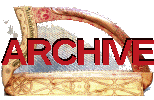
|
As well as extant surviving historical instruments and documentary sources, a third source of evidence for historical Gaelic harp performance practice is contemporary visual art.
These old pictures need to be used with care, since in most cases they are not photographic or true-to-life records of actual practice, but are stylised or caricatured images intended to make a rhetorical or artistic point.
Also note that many of them are distorted or degraded due either to a lack of attention by the artists to technical matters, or from the ravages of time. It's important to realise that medieval stone sculptures were originally intended to be painted, so many details may have not been carved at all.
Finally, it is impossible to tell with many of the more abraded images, whether the object being held by the person is a Gaelic harp or some other kind of harp, and in many cases if it is even a musical instrument at all. This list is a work in progress. If you have additions, please let me know.

9th-10th century Monifieth stone
This stone cross-shaft (now in the National Museum of Scotland, Edinburgh) bears various figures including a seated figure holding a triangular stringed instrument; the surface is very weathered and abraded though the relief is high. This depiction is usually classed as a 'Pictish' harp but we really don't know what kind of an instrument it might be, and whether it would more likely belong to the Gaelic or Continental harp families. There are a number of other, similar, depictions from 9th-10th century Scottish stones showing either a figure holding a harp, or a harp alone. More on early medieval depictions...

early 10th century Cross of Muiredeach
On this high cross in the cemetery of the monastery of Monasterboice, County Louth, is a musician as part of the cricifixion scene. Because of the abraded surface of the carving it is not clear exactly what kind of instrument is being played. Also, the entire figure is compressed into a tapering field on the cross arm. Respected scholars have argued that this is an otherwise unknown form of lyre, but it seems possible that it is instead a triangular harp held between the knees. A bird is perched on top of the instrument. There is a second similar carving on the the South cross at Kells. More...
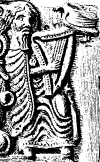
c. 11th century Breac
Maedóic reliquary (shrine of St. Mogue)
This tiny silver-gilt depiction of a harper shows characteristic features including the fish lips on the forepillar and the left orientation of the harper. The harp has a bird standing on top of it. This image is often cited as the earliest unambiguous depiction of an Irish harp.
It is on display in the National Museum of Ireland, Kildare Street, Dublin. More...

c. 1200 Ardmore Cathedral stone relief
This frieze has been re-assembled in the gable wall of the ruined cathedral and shows a harper. The surface is very abraded and there is no detail. Though the forepillar is clearly curved, the neck appears to be straight, and without the Irish provenance this depiction would be one amongst hundreds of unremarkable harp depictions from medieval Europe.
More...

mid 14th century Fiacail Phádraig reliquary (the Shrine of St. Patrick's Tooth)
This small metal relief fixed to the shrine depicts King David playing a harp. He uses a left orientation. His harp is quite slender, and does not look specifically Gaelic, so is comparable to the many contemporary European depictions of David playing the harp. The shrine is now on display in the National Museum of Ireland, Kildare St, Dublin.
More...
14th century Clare Island wall paintings
These frescos are quite damaged. They include two sketchy drawings of musicians. The harp seems to be similar to contemporary continental depictions, and is held in a right orientation.
Harp player image link
Lyre player image link

c. 14th-15th century Iona burial stone
This very abraded inscribed grave slab shows a seated figure playing a small low headed harp. Because the surface is so weathered, no detail can be made out. According to some published drawings and descriptions, the harper is sitting in a tiny boat, but it seems that it may be a cushion or chair instead. More...

15th century Kilchoan grave slab
This grave slab shows a kneeling figure playing a low-headed harp. The surface is abraded away so no details are visible. the rest of the slab contains a large sword, and a figure of a bishop or churchman as well as other motifs.
More...

Late 15th century Keills grave slab
This grave slab shows a harp on its own with no player. A drawing published in T. P. White, Archaeological Sketches in Scotland, Knapdale and Gigha, 1875, shows the harp decorated with diagonal lines on the soundbox. These are strikingly similar to the designs on the Queen Mary and Trinity College harps. However these details seem to have eroded away since then. More...

Early 16th century Jerpoint Abbey tomb effigy
This tomb effigy shows a couple lying with a miniature harp beside them. Though the harp is shrunken, it is very similar in form to the Queen Mary and Trinity harps. Confusion has been caused by claims that it is most similar to the Lamont. Although it is weathered from being exposed outside, and there is severe damage to some sections of the sculpture (including to the bass end of the neck and the upper part of the forepillar), it displays many very detailed characteristics including the fish-lips on the forepillar, the raised stringband and 'eyebrows' on the soundbox, and the brass cheek strap on the neck. More...

1581 John Derrick, The Image of Ireland
This book, published in London, includes a caricature of an Irish harper. Though the harp does not have any useful technical details at all, it is interesting to see the harper sitting on the ground, and accompanying a singer who is using dramatic gestures. The engraving also shows a chieftain sitting at table listening to the music, attended by either priests or poets. View the complete series of engravings at Edinburgh University Library.

c. 1604 Edzell Castle garden stone
This decorative panel depicts Musica surrounded by instruments, one of which is a miniature Gaelic harp. more info from the Wire Branch of the Clarsach Society.

1619 Praetorius, Syntagma Musicum This engraved plate in a printed book shows a large 43-string low-headed harp, and captioned "Irlandisch harff mit messinges saiten" (Irish harp with brass strings). The text gives a partly chromatic tuning and a scale of inches. The harp has many interesting characteristic features ncluding the metal straps, and the profile of the forepillar and neck. more info from the Wire Branch of the Clarsach Society.

1622 Reinholdt Thim painting
This portrait of the musicians of the Danish king include an Irish harper with a large low headed instrument. The end-on orientation of the harp obscures most of the interesting detail. He is using a left orientation, and tilting his harp at an angle on its (obscured) projecting block. The other musicians in the painting are a bass viol player, a flautist, and a lute player. The painting is in the National Museum of Denmark.
more info from the Wire Branch of the Clarsach Society.

c. 1623 Hill House, nr Dunfermline
This stone carving on the outside of Hill House is weathered and is also drawn in a very stylised naïve style. The harp has both Gaelic and Continental features and seems to be held in a right orientation. A photograph and a description of this carving were published by Keith Sanger and Alison Kinnaird, Tree of Strings - Crann nan Teud, Kinmor 1992, p. 97. More...

c. 1662 Kilravock Castle fireplace
This stone fireplace lintel has a mermaid on it, holding a low-headed harp. The second mermaid from the other end is lost. The stone was outside for some time and so is quite weathered; it is now inside again as part of a fireplace.
More info from the Wire Branch of the Clarsach Society.

c. 1679 Kilcoy Castle fireplace
This stone fireplace lintel has two mermaids on it, each holding a large low-headed harp. The harps are sturdy and solid looking, and show the projecting block and the brass cheek-bands of a Gaelic harp. The harps are of a substantial size compared to the figures holding them. more info from the Wire Branch of the Clarsach Society.
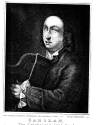
c.1730 Turlough Carolan (1670 - 1738), from Nobber, co. Westmeath.
This portrait of Carolan exists as both an engraving and an oil painting. Few details of his harp are visible; the neck seems to be set into the front of the soundbox instead of into the top.
Read More about Carolan...
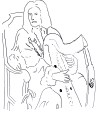
c. 1750 William Archdeacon (1685-1759)
This portrait of Archdeacon and his family shows him holding a low-headed harp. He holds it very low in a left orientation. The harp bears the Archdeacon crest on its forepillar. This painting is in a private collection in the Netherlands. More info at the JMI.
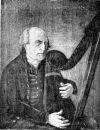
Late 18th c. This is an 18th century oil painting by Conn O’Donnell, in the National Gallery of Ireland. It is often said to be of Arthur O’Neill, though I don’t think this is true. It's also been claimed to show Cormac Ó Ceallaigh. The painting is currently in very poor condition, and I have not been able to get a colour reproduction from the gallery. Many thanks to the Irish Traditional Music Archive for supplying me with a scan of the reproduction published in Ceol, Winter 1963 and giving me permission to reproduce it here.

1786 Walker's Irish Bards
Walker published this engraving to illustrate his book. He describes it as a harp belonging to Jonathan Hehir of Limerick, and says that it bore an inscription "Made by John Kelly in 1726". John Kelly also made the similar Bunworth harp which is now in the Museum of Fine Arts, Boston. Characteristic technical features of the instrument are clearly visible, but because the harp is represented as part of a trophy of instruments in a romantic landscape, we see no hints on playing technique. This is Armstrong's 1904 redrawing.

c.1800 Patrick Quin (c. 1745 - post 1812)
This engraved portrait of Quin was published by R.B. Armstrong in 1906; it is loosely based on a watercolour portrait in the Ulster Museum, Belfast (Brian Audley ‘A newly discovered portrait of Patrick Quin, the harper, c. 1745 - 1812’ Treoir (Comhaltas Ceoltóirí Éireann) Vol 26 No. 4, 1994 ). In the watercolour, Quin is holding the large low-headed Castle Otway harp.
Read more about Patrick Quin...
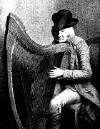
1809 Denis O'Hampsey (1695 - 1807), also known as Denis Hempson, from Magilligan, co. Derry.
O'Hampsey was the most important source for the techniques and repertory of the old Gaelic harpers. This portrait was published in 1809. It shows O'Hampsey holding the Downhill harp.
Read more about Denis O'Hampsey...
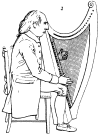
1809 Arthur O’Neill (1737 - 1816)
This portrait was published by Bunting in 1809. There are two other related engravings of Arthur O'Neill in the same pose, one in C.M. Fox's Annals of the Irish Harpers and one published by in the Ulster Journal of Archaeology, July 1906, p.100. He is holding quite a large scroll-topped harp in a left orientation.

1810 Charles Byrne (c.1718 - c.1810) from co. Leitrim.
Also called Berreen, he attended the Belfast harpers’ meeting in 1792, as well as the earlier Granard balls. He gave Bunting a number of songs and airs. He was sighted and in his youth had acted as a guide to his blind uncle, who may have been the Charles Byrne known by Carolan.
Bunting tells us that Byrne’s portrait was sketched by Miss O’Reilly of Scarva. When Charlotte Milligan Fox found and published this drawing from Bunting's papers, in her 1911 book, she assumed that this was Miss O’Reilly’s sketch of Byrne. There is an interesting inscription drawn along the pillar of the harp.
1838 Patrick Murney
One of the students of the Belfast Harp Society. Two sketches by Lady Dufferin show Murney as a young boy playing his big Egan wire-strung early Irish harp. Reproduced in Charlotte Milligan Fox (ed. Sara C. Lanier), Annals of the Irish Harpers, Ardrigh Books 2013, plates 10 & 11.
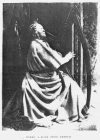
1845 Patrick Byrne (1794 - 1863) from Kingscourt, co. Cavan.
A student at the Belfast Harp Society in 1821, Byrne subsequently toured throughout Britain. This Calotype photograph was taken in Edinburgh by the photography pioneers Hill & Adamson. A number of other photographs of Byrne exist in collections in the UK and USA. His harp is one of the 'Society' instruments made by Egan in the early 19th century.
Read More about Patrick Byrne...

1889 Captain Arthur Magenis’s harp
A watercolour portrait of a harp commissioned from harpmaker Cormac O’Kelly in 1711. The harp has similarities to other harps by O’Kelly, most obviously the Downhill harp but also the Castle Otway. The side of the soundbox has an inscription: “Ego sum Regina Musarum Made by Cormick O / Kelly for Captain Arth Magenis 1711”. This harp is now lost; it is presumably the one seen and described by Petrie, in O’Curry’s Manners & Customs of the Ancient Irish (1873), vol 3 p.295-6.
Read more: Article by Michael Billinge with photo by Keith Sanger
Simon Chadwick